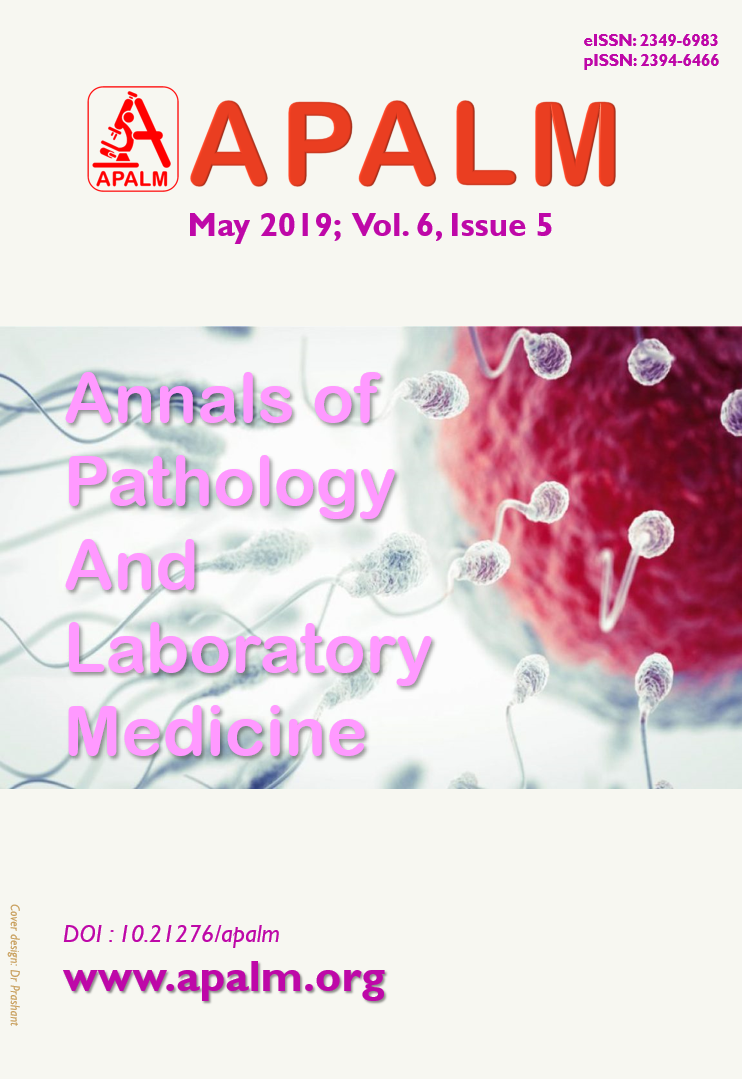Correlation of Total Sperm Count with Presence of Round Cells and Abnormal Sperm Morphology in Semen Analysis
DOI:
https://doi.org/10.21276/apalm.2372Keywords:
Morphological defects, round cells, semen analysis, total sperm countsAbstract
Background: Among the routine semen parameters, presence of round cells and morphological defects in sperms are important qualitative parameters in semen analysis. Detailing the "round cells" and qualitative defects in sperms becomes important as these factors affect fertility. In this study, we aim to categorise and assess the percentage of round cells and morphological defects of sperms in correlation with total sperm count.
Methods: 70 random semen samples were included which were collected from males being evaluated for infertility. They were divided into two groups based on the total sperm count. Papanicolaou stained smears were studied for categorisation of round cells and qualitative defects in sperms .These were then correlated with total sperm count.
Result: We observed that both the groups showed presence of round cells and morphological defects in sperms with a slightly higher percentage in reduced sperm counts. Round cells observed in our study included immature germ cells, leucocytes and epithelial cells. Frequent morphological defects were round head, large head and coiled tail.
Conclusion: Round cells and morphologically defect sperms are frequently observed in semen samples with reduced sperm counts compared to normal sperm counts.
References
2.Goyal R, Kotru M, Gogia A, Sharma S. Qualitative defects with normal sperm counts in a patient attending infertility clinic. Indian J Pathol Microbiol .2018;61:233-5
3.Ara MJ, Hussain SMB, Rashid MU. Role of male partners in 100 infertile couples. JAFMC Bangladesh.2015 June;11(1):50-3
4.World Health Organisation. WHO Laboratory Manual for the examination and processing of human semen,5th ed. Geneva: WHO Press 2010.
5.Nikolettas N, Kupker W, Demirel C, Schopper B, Blasig C, Sturm R. Fertilisation potential of spermatozoa with abnormal morphology. Human Reprod 1999;14(1):47-70
6.Karabulut A, Tekin A. Alterations in the morphology and motility of spermatozoa: Relation with sperm count. Pam Med J 2013;6:1-4.
7.Andrade R. Sperm parameters in men with suspected infertility. Sperm characteristics, strict criteria sperm morphology analysis and hypoosmotic swelling test. J Reprod Med 2001;46:577-82
8.Cao X, Cui Y, Zhang X. Lou J, Zhou J, Wei R et al. The correlation of sperm morphology with unexplained recurrent spontaneous abortion: A systematic review and meta analysis. Oncotarget 2017;8:55646-56
9.Auger J, Eustache F, Andersen AG, Irvine DS, Jorgensen N, Skakkebaek NE et al. Sperm morphological defects related to environment, lifestyle and medical history of 1001 male partners of pregnant women from European cities. Hum Reprod 2001;16:2710-7
10.Johanisson E, Campana A, Luthi R, de Agostini A. Evaluation of roundcells in semen analysis: A comparative study. Human reproduction Update.2000;6(4):404-412
11.Palermo DG, Neri QV, Cozzubbo T, Cheung S, Pereira N, Rosenwaks Z. Shedding light on the Nature of Seminal round cells. PLoS OBE .2016 March;11(3):1-18
12.Fedder J, Askjaer SA, Hjort T. Non spermatozoal cells in semen: Relationship to other semen parameters and fertility status of the couple. Arch Androl 1993;31:95-103.
13.Gandini L, Lenzi A, Lombardo F, Pacifi R, Dondero F. Immature germ cell separation using a modified discontinuous percoll gradient technique in human semen. Human Reprod 1999;14:1022-7
14.Ariagno J, Curi S, Mendeluk G, Grinspon D, Repetto H, Chenio P et al, Shedding of immature germ cells. Arch Androl 2002;48:127-31
15.Politich JA, Wolff H, Hill JA, Anderson DJ. Comparison of methods to enumerate white blood cells in semen. Fertil Steril 1993:60 :372-5.
Downloads
Published
Issue
Section
License
Copyright (c) 2019 Thejasvi Krishnamurthy, Yashica Gowda R

This work is licensed under a Creative Commons Attribution 4.0 International License.
Authors who publish with this journal agree to the following terms:
- Authors retain copyright and grant the journal right of first publication with the work simultaneously licensed under a Creative Commons Attribution License that allows others to share the work with an acknowledgement of the work's authorship and initial publication in this journal.
- Authors are able to enter into separate, additional contractual arrangements for the non-exclusive distribution of the journal's published version of the work (e.g., post it to an institutional repository or publish it in a book), with an acknowledgement of its initial publication in this journal.
- Authors are permitted and encouraged to post their work online (e.g., in institutional repositories or on their website) prior to and during the submission process, as it can lead to productive exchanges, as well as earlier and greater citation of published work (See The Effect of Open Access at http://opcit.eprints.org/oacitation-biblio.html).










